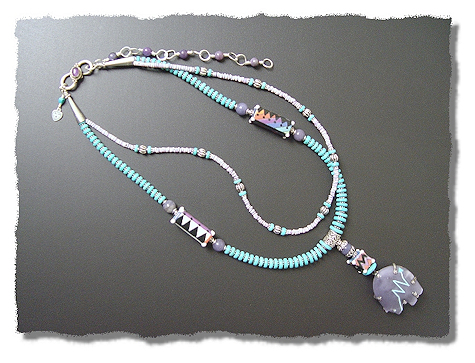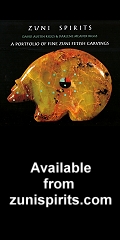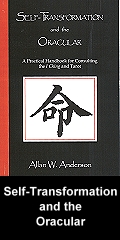This diminutive medicine bear is carved in Stewart Quandelacy's signature style (note his bear on the cover of McManis' definitive Zuni Fetishes and Carvings below). The slightly dated but fascinating book The Fetish Carvers of Zuni shows an earlier Stewart bear with a straight heartline, but the ones I have seen more recently are beautifully elaborated like this one. David and Darlene Riggs have produced a gorgeous book of Zuni carvings (Zuni Spirits, see below) which has two of Stewart's broad-shouldered bears. One has the heartline on the right, as does the one on the McManis cover, the other, like this sweet purple bear has it on the left. The heartline is also called "spirit line" and "breath line" and according to Bahti, there is no word for it in the Zuni language. I discussed the mythology of the heartline at some length in relation to another Stewart bear here, quoting Cushing's 1881 Zuni Fetiches. Cushing wandered in to Zuni as a young man working for the Smithsonian Institution, was welcomed by the people and wrote extensively about the Zuni.
The bear is the protective and healing animal of the west. Bennett says of Bear, "If you are feeling overwhelmed by events, either in the
external or internal world, place Black Bear before you, its back to the west, its face to the east..." then proceeds to offer meditation
exercises which could be of help. Bennett does not claim to represent Zuni spirituality (and in fact does not) but rather offers a starting place whereby a non-Zuni
might begin to learn the power of these symbols.
For a wonderful collection of stories about Bear and many other creatures, consider Craig Childs' The Animal Dialogues - Uncommon
Encounters in the Wild. One of his essays on Bear contains this gem, "In the dark before sunrise I wake and move again, no particular
task in my mind but turning the pages of the world, seeing what comes next..." How like Bear whom he follows without following.
Now what exactly was the bear carved from? Labeled "Fluorite", it didn't feel like Fluorite somehow. A reader corrected my ramblings on the subject saying it is Yttrium Fluorite, a rare, very dense form of Fluorite. Metaphysical properties for it differ from those of the more common purple Fluorite. Some web articles indicate Yttrium Fluorite is a grounding stone, some speak of psychic gifts, etc. At the time of writing, most web articles and images say Yttrium Fluorite is pale lavender (much lighter in color than the bear) ... but then there's the fellow who bought one of the pale stones and had it tested by x-ray fluorescence spectroscopy at the Center for Microanalysis of Materials, University of Illinois and they found no Yttrium in it whatsoever. So that might explain why our bear is so different from the images on the web. I should avoid speculating whether a stone is this or that, shouldn't I? Whatever, now I want a nice piece of Yttrium (element 39) to add to a necklace... so many elements, so little time!
The Lepidolite beads match the little bear well. Ahsian notes that "Lepidolite encourages release of
identification with the ego and acceptance of the present moment as a dwelling place for the soul." Not only does this suggest that Lepidolite
could be helpful in "turning the pages of the world, seeing what comes next" just like Bear, but she makes a distinction here which is
rarely made. There is so much New Age talk about the "necessity" for the ego to die it seems to me her clarification is much needed. My
own teacher has always maintained the Hindu Advaita position that there is nothing inherently wrong with the ego-making function, in fact
it is rather handy. Were there no "I-maker" how could we distinguish ourselves from the oncoming bus? According to this view, our problems
arise from our identification with ego, not from ego itself. One of my teacher's books, Self Transformation and
the Oracular, is referenced below.
I hope you will order this sweet bear and that you will find him a wise companion on your travels within and without.









